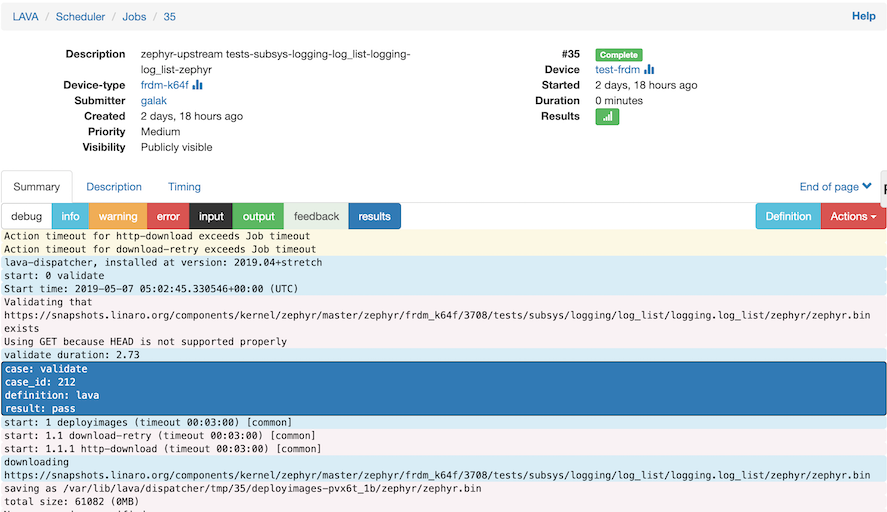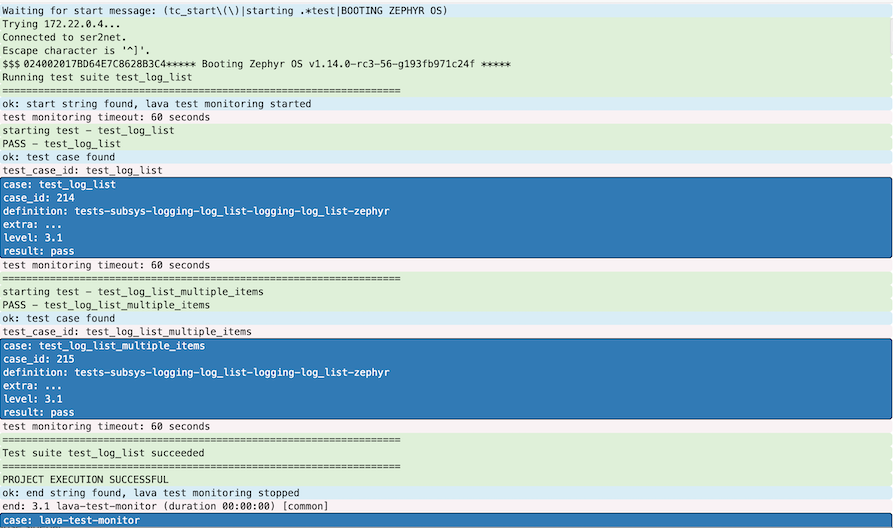...
Optional: Setup access for local IP/host
If you are running lava on a machine with a fixed IP (eg: a dedicated computer on your local network) you will want to modify the
overlays/lava-server/etc/lava-server/settings.conffile to allow access. You'll want to modify theALLOWED_HOSTSline to add the ip or hostname of the machine. In the example below, the ip192.168.1.14was added, you'll want to keep127.0.0.1andlocalhost.Code Block language yml linenumbers true { "HTTPS_XML_RPC": false, "MOUNT_POINT": "/", "STATIC_URL": "/static/", "ALLOWED_HOSTS": ["192.168.1.14", "127.0.0.1", "localhost"], "CSRF_COOKIE_SECURE": false, "SESSION_COOKIE_SECURE": false, "EVENT_NOTIFICATION": true, "EVENT_TOPIC": "lava-server", "INTERNAL_EVENT_SOCKET": "tcp://lava-publisher:5557" }- Optional: Add the proxy settings in lite-lava-dispatcher and ser2net images
It might be required to define proxy setting in lite-lava-dispatcher/Dockerfile and ser2net/Dockerfile
Code Block language bash ENV http_proxy=http://<user>:<pwd>@<proxy>:<port> ENV https_proxy=http://<user>:<pwd>@<proxy>:<port>
- Optional: Configure DNS in /etc/docker/daemon.json
Get host DNS
Code Block language bash nmcli dev show | grep 'IP4.DNS'
Set reported value in /etc/docker/daemon.json
Code Block language yml { "dns": ["w.x.y.z"] } Run commands to build docker images and startup lava
Code Block language bash docker-compose build make
You'll see output of docker fetching and building the images, and then all LAVA containers starting up, followed by a fair amount of logging from LAVA itself as it starts up. This may take a few minutes to complete.
Here are some examples of the output one can expect during this phase:
Docker Compose/Build Phase
Code Block language bash galak@ubuntu:~/lava-docker-compose$ make docker-compose up Creating volume "lava-server-pgdata" with default driver Creating volume "lava-server-devices" with default driver Creating volume "lava-server-health-checks" with default driver Creating volume "lava-server-joboutput" with default driver Pulling db (postgres:11.2-alpine)... 11.2-alpine: Pulling from library/postgres bdf0201b3a05: Pull complete 365f27dc05d7: Pull complete bf541d40dfbc: Pull complete 823ce70c3252: Extracting [========> ] 4.194MB/25.04MB a92a31ecd32a: Download complete 83cc8c6d8282: Download complete 7995b9edc9bf: Download complete 7616119153d9: Download complete b3f69561e369: Download complete
Lava containers being created
Code Block language bash Creating lava-server-db ... done Creating lava-dispatcher ... done Creating lava-ser2net ... done Creating lava-publisher ... done Creating lava-master ... done Creating lava-logs ... done Creating lava-server ... done Creating apache2 ...
Lava starting up
Code Block language bash lava-master | Applying lava_results_app.0012_namedtestattribute_metadata... OK lava-server | . lava-master | Applying lava_results_app.0013_buglinks... OK lava-master | Applying lava_results_app.0014_xaxis_maxlength_increase... OK lava-master | Applying dashboard_app.0002_auto_20140917_1935... OK lava-logs | . lava-master | Applying dashboard_app.0003_auto_20140926_1208... OK lava-master | Applying dashboard_app.0004_imagereportchart_is_delta... OK lava-dispatcher | 2019-05-09 19:01:08,522 DEBUG [BTSP] Checking master [lava-master:5556] to create socket for lava-dispatcher lava-dispatcher | 2019-05-09 19:01:08,524 DEBUG [BTSP] socket IPv4 address: 172.18.0.6 lava-dispatcher | 2019-05-09 19:01:08,525 INFO [BTSP] Greeting master => 'HELLO_RETRY' (using the same version?) lava-master | Applying dashboard_app.0005_imagereportchart_chart_height... OK lava-master | Applying dashboard_app.0006_auto_20141028_1146... OK lava-master | Applying dashboard_app.0007_imagereportchart_chart_visibility... OK lava-server | . lava-master | Applying dashboard_app.0008_imagechartfilter_is_all_tests_included... OK
Lava idle
Code Block language bash lava-dispatcher | 2019-05-09 19:03:21,510 DEBUG PING => master (last message 20s ago) lava-master | 2019-05-09 19:03:21,513 DEBUG lava-dispatcher => PING(20) lava-dispatcher | 2019-05-09 19:03:21,519 DEBUG master => PONG(20) lava-master | 2019-05-09 19:03:36,201 INFO scheduling health checks: lava-master | 2019-05-09 19:03:36,205 INFO scheduling jobs: lava-master | 2019-05-09 19:03:38,651 DEBUG lava-logs => PING(20) lava-logs | 2019-05-09 19:03:38,648 DEBUG PING => master lava-logs | 2019-05-09 19:03:38,657 DEBUG master => PONG(20) lava-master | 2019-05-09 19:03:41,549 DEBUG lava-dispatcher => PING(20) lava-dispatcher | 2019-05-09 19:03:41,546 DEBUG PING => master (last message 20s ago) lava-dispatcher | 2019-05-09 19:03:41,555 DEBUG master => PONG(20) lava-master | 2019-05-09 19:03:56,221 INFO scheduling health checks: lava-master | 2019-05-09 19:03:56,225 INFO scheduling jobs: lava-logs | 2019-05-09 19:03:58,681 DEBUG PING => master lava-master | 2019-05-09 19:03:58,684 DEBUG lava-logs => PING(20) lava-logs | 2019-05-09 19:03:58,690 DEBUG master => PONG(20) lava-master | 2019-05-09 19:04:01,579 DEBUG lava-dispatcher => PING(20) lava-dispatcher | 2019-05-09 19:04:01,577 DEBUG PING => master (last message 20s ago) lava-dispatcher | 2019-05-09 19:04:01,584 DEBUG master => PONG(20)
Verify lava is running
You can verify that lava has completed startup by trying to connect to the LAVA webserver in a web browser by going to localhost.
Here's what the startup webpage should look like in your web browser:
...
| Code Block | ||
|---|---|---|
| ||
sudo contrib/udev-forward.py -i lava-dispatcher |
Bringing up LAVA setup after host reboot
At the time of writing, the docker-compose configuration is set to automatically start on system (re)boot. However, not all containers comprising the system may start up automatically. You check the status by going to lava-docker-compose directory and running "docker-compose ps". Example output after system reboot is shown below (it may differ for your system):
...
| language | bash |
|---|
...
Sending the board a job
Now that we've got everything set, we can try and send an actual job to the board. A job will try and fetch a binary to flash the board with from a URL. How job files are composed is outside of the scope of this guide. However, we provide an example job file to test and verify that everything is working. In the repository example/lava.job is a YAML structured job file. If you look at the file, you'll see a reference to https://snapshots.linaro.org/components/kernel/zephyr/master/zephyr/frdm_k64f/3708/tests/subsys/logging/log_list/logging.log_list/zephyr/zephyr.bin this file will be fetched and flashed to the board using the boot method cmsis-dap (which is specified in this file).
We utilize lavacli to submit the job file to the lava server. The command will return a number to the user which is the job number (ID). We can then utilize a web browser to see the results of the job.
Submit a job
Note: the second line is the output of submitting the job, with the job ID 1
Code Block language bash lavacli -i dispatcher jobs submit example/lava.job 1See job results
The job results are available at
http://localhost/scheduler/job/<JOB ID>. The case above, the job ID is 1, so the URL would behttp://localhost/scheduler/job/1. As with all other URLs, if you have a fixed IP/hostname you can replacelocalhostwith that IP/hostname.The following screen captures try to give a sense of the output you should see, it's not a complete log of everything you will see, however we do show the final output and passing of the test:
The start of the job:
You might get the following certificate error.
| Code Block |
|---|
Job error: Invalid job data: ["Unable to get 'https://snapshots.linaro.org/components/kernel/zephyr/master/zephyr/frdm_k64f/3708/tests/subsys/logging/log_list/logging.log_list/zephyr/zephyr.bin': HTTPSConnectionPool(host='snapshots.linaro.org', port=443): Max retries exceeded with url: /components/kernel/zephyr/master/zephyr/frdm_k64f/3708/tests/subsys/logging/log_list/logging.log_list/zephyr/zephyr.bin (Caused by SSLError(SSLError(1, '[SSL: CERTIFICATE_VERIFY_FAILED] certificate verify failed (_ssl.c:720)'),))"] |
You then need to bind your host certificates to container by adding following line in lava-docker-compose/docker-compose.yaml:
| Code Block | ||
|---|---|---|
| ||
lava-master:
container_name: lava-master
image: ${DC_SERVER_IMAGE}
volumes:
...
- /usr/local/share/ca-certificates:/usr/local/share/ca-certificates:ro |
Then, run the following command in the container and go back to job start step.
| Code Block |
|---|
update-ca-certificates |
The job continues, we see some output result from the board in light green:
The Final output, we see the 'result:pass'
Bringing up LAVA setup after host reboot
At the time of writing, the docker-compose configuration is set to automatically start on system (re)boot. However, not all containers comprising the system may start up automatically. You check the status by going to lava-docker-compose directory and running "docker-compose ps". Example output after system reboot is shown below (it may differ for your system):
| Code Block | ||
|---|---|---|
| ||
Name lava-server Command /root/entrypoint.sh Up 5500/tcp, 5555/tcp, 5556/tcp, 80/tcp State lava-server-db docker-entrypoint.sh postgres Up Ports 5432/tcp |
As can be seen, lava-dispatcher and lava-ser2net containers didn't start up successfully. This usually can be rectified by running "docker-compose up". To bring up the system into a fully functional state, udev forwarder must be started manually too.
Sending the board a job
Now that we've got everything set, we can try and send an actual job to the board. A job will try and fetch a binary to flash the board with from a URL. How job files are composed is outside of the scope of this guide. However, we provide an example job file to test and verify that everything is working. In the repository example/lava.job is a YAML structured job file. If you look at the file, you'll see a reference to https://snapshots.linaro.org/components/kernel/zephyr/master/zephyr/frdm_k64f/3708/tests/subsys/logging/log_list/logging.log_list/zephyr/zephyr.bin this file will be fetched and flashed to the board using the boot method cmsis-dap (which is specified in this file).
We utilize lavacli to submit the job file to the lava server. The command will return a number to the user which is the job number (ID). We can then utilize a web browser to see the results of the job.
Submit a job
Note: the second line is the output of submitting the job, with the job ID 1
| Code Block | ||
|---|---|---|
| ||
lavacli -i dispatcher jobs submit example/lava.job
1 |
See job results
The job results are available at http://localhost/scheduler/job/<JOB ID> . The case above, the job ID is 1, so the URL would be http://localhost/scheduler/job/1 . As with all other URLs, if you have a fixed IP/hostname you can replace localhost with that IP/hostname.
...
You might get the following certificate error.
| Code Block |
|---|
Job error: Invalid job data: ["Unable to get 'https://snapshots.linaro.org/components/kernel/zephyr/master/zephyr/frdm_k64f/3708/tests/subsys/logging/log_list/logging.log_list/zephyr/zephyr.bin': HTTPSConnectionPool(host='snapshots.linaro.org', port=443): Max retries exceeded with url: /components/kernel/zephyr/master/zephyr/frdm_k64f/3708/tests/subsys/logging/log_list/logging.log_list/zephyr/zephyr.bin (Caused by SSLError(SSLError(1, '[SSL: CERTIFICATE_VERIFY_FAILED] certificate verify failed (_ssl.c:720)'),))"] |
You then need to bind your host certificates to container by adding following line in lava-docker-compose/docker-compose.yaml:
| Code Block | ||
|---|---|---|
| ||
lava-master:
container_name: lava-master
image: ${DC_SERVER_IMAGE}
volumes:
...
- /usr/local/share/ca-certificates:/usr/local/share/ca-certificates:ro |
Then, run the following command in the container and go back to job start step.
| Code Block |
|---|
update-ca-certificates |
...
----------------------------------------------------------------------------------------------------------------
apache2 /root/entrypoint.sh Up 5500/tcp, 5555/tcp, 5556/tcp, 0.0.0.0:80->80/tcp
lava-dispatcher /root/entrypoint.sh Exit 255
lava-logs /root/entrypoint.sh Up 5500/tcp, 0.0.0.0:5555->5555/tcp, 5556/tcp, 80/tcp
lava-master /root/entrypoint.sh Up 5500/tcp, 5555/tcp, 0.0.0.0:5556->5556/tcp, 80/tcp
lava-publisher /root/entrypoint.sh Up 0.0.0.0:5500->5500/tcp, 5555/tcp, 5556/tcp, 80/tcp
lava-ser2net /bin/sh -c echo -n "Starti ... Exit 255
lava-server /root/entrypoint.sh Up 5500/tcp, 5555/tcp, 5556/tcp, 80/tcp
lava-server-db docker-entrypoint.sh postgres Up 5432/tcp |
As can be seen, lava-dispatcher and lava-ser2net containers didn't start up successfully. This usually can be rectified by running "docker-compose up". To bring up the system into a fully functional state, udev forwarder must be started manually too.



